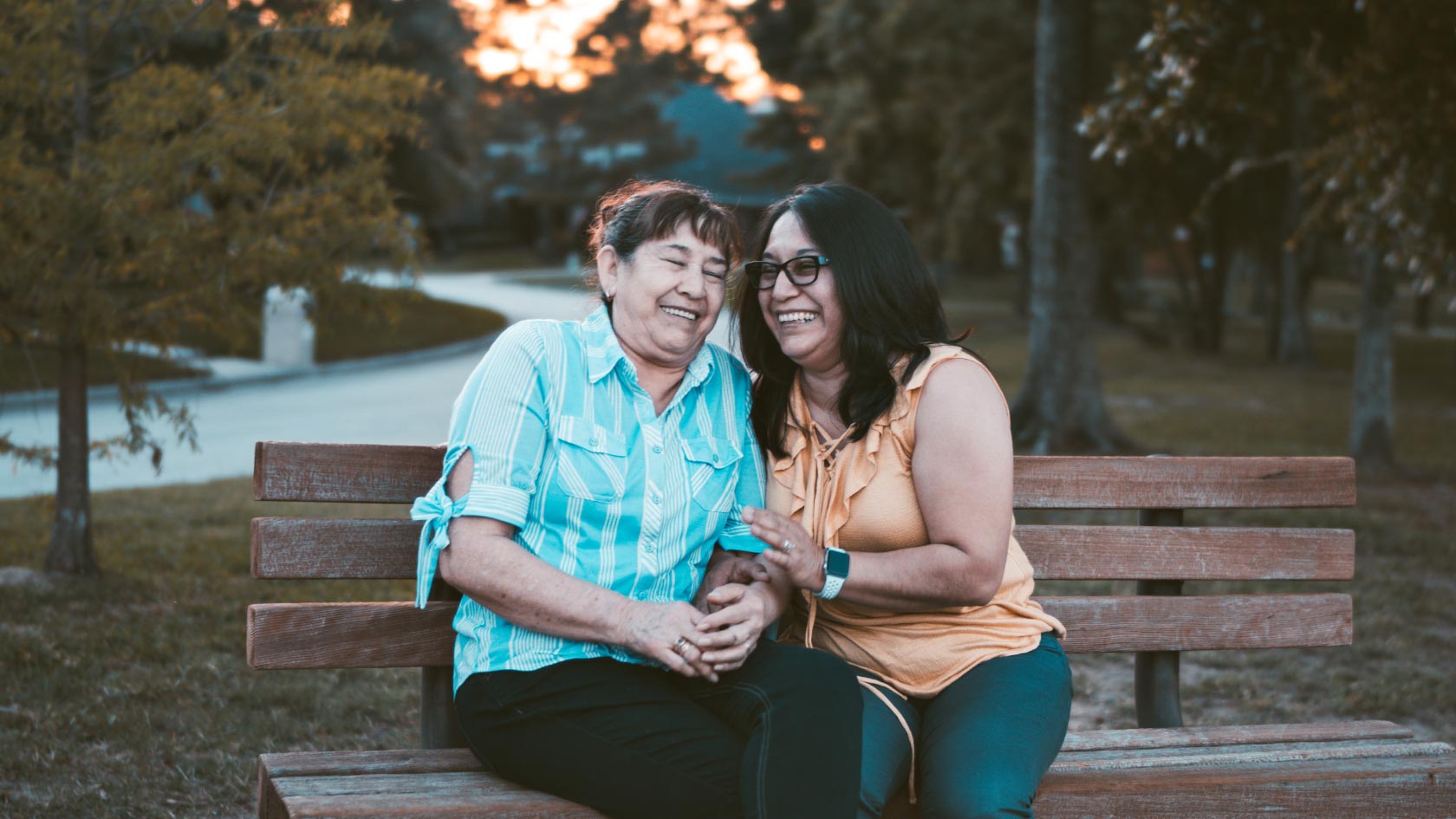Bringing a Comprehensive Approach to Dementia Care
Millions of people struggle with the demands of caring for a loved one with dementia. EDC’s Kristin Lees Haggerty leads a conversation about programs that could offer relief.

In the United States, many people with dementia—including the nearly 7 million Americans with Alzheimer’s disease—rely on a network of friends, family members, and health professionals to help manage their care. It’s a reality that places the complicated health, legal, and financial responsibilities of dementia caregiving squarely on the shoulders of loved ones, often with little support or guidance.
Comprehensive dementia care programs, which offer caregiver support and coordination of care, do exist. Research has shown that they improve patient outcomes while supporting the needs of caregivers. However, health systems and community partners have been slow to implement these programs because of the financial cost of hiring staff and putting in systems specifically for comprehensive dementia care.
Innovation is on the way. The Centers for Medicare and Medicaid Services (CMS) has launched a new, eight-year demonstration project called Guiding an Improved Dementia Experience (GUIDE) Model to transform support for caregivers and people living with dementia. With an explicit objective to reduce strain on their unpaid caregivers,” the GUIDE Model pays Medicare-participating organizations that implement comprehensive dementia care programs a monthly fee per beneficiary enrolled in the program, alleviating some of the financial barriers to widespread adoption.
In this roundtable, EDC’s Kristin Lees Haggerty leads a conversation about how the National Dementia Care Collaborative at EDC and Best Programs for Caregiving, two resources funded by The John A. Hartford Foundation, are working to advance the GUIDE Model’s goals and improve the current state of dementia care. Her guests are EDC’s Gary Epstein-Lubow, a geriatric psychiatrist, and two experts from the Benjamin Rose Institute on Aging: David Bass, senior vice president of research and education, and Morgan Minyo, a research scientist. Their conversation has been edited for clarity and brevity.
Let’s set the scene. Why is there so much attention on dementia care and services right now?
Gary Epstein-Lubow: Simply, the population is aging, and the number of people living with some form of dementia is growing. The resources available to support people living with dementia and their families have historically been limited and fragmented. When someone is diagnosed with dementia, they are seldom provided with an integrated care plan to address their health needs. So they and their caregivers often have to cobble together a plan for care. The federal government has done a lot of work to create a national plan for how to improve dementia services, but implementing that plan has been slow, until now.
David Bass: For three decades, there have been very strong efforts to improve dementia care and to bring attention to dementia as a condition that has been hidden and stigmatized. That stigma is changing. The growing numbers of people living with dementia, as Gary said, is one reason. More families are experiencing it first-hand. There’s also been important work by researchers, policymakers, and organizations like the Alzheimer’s Association. We’re making progress.
Lees Haggerty: With funding from The John A. Hartford Foundation, EDC and Benjamin Rose Institute on Aging are working together to promote “comprehensive dementia care” programs. What does that term mean?
Bass: Comprehensive dementia care addresses the medical and non-medical needs of both the person and their caregivers. It really is about listening to what people living with dementia and their families want and trying to meet those needs.
Epstein-Lubow: Comprehensive dementia care is relatively new. Primary care clinicians and neurologists have had few resources to integrate social services into the care that they provide to patients living with dementia and their family members. It was partly in response to complaints from family members about not having support after their loved one receives a diagnosis of dementia that led to the GUIDE Model.
Bass: Right. And as Gary noted, care is very fragmented. Many families don’t have anyone to turn to. Dementia is a disease where things are always changing. Comprehensive care addresses the progression of the disease and issues that caregivers face while balancing other roles and responsibilities.
Lees Haggerty: Families and friends play such an important role in helping people living with dementia navigate the disease. How do comprehensive programs support these caregivers?
Bass: One of the key things comprehensive programs provide is a “care navigator” or “care coach” who has expertise and experience with all types of issues related to dementia. Ideally, that person maintains a long-term relationship with caregivers and persons living with dementia. They provide quality information, and they help caregivers find and use resources and services from a variety of agencies. For family and friend caregivers, it’s hard to find those services or get accurate information about them. The role of that care navigator is really important.
Lees Haggerty: How is the National Dementia Care Collaborative (NDCC) supporting the dissemination and uptake of comprehensive programs, including with the GUIDE Model?
Epstein-Lubow: The NDCC includes six comprehensive dementia care programs that came together to promote better care. The goal of NDCC is to accelerate the scale and spread of these programs so that more communities can access comprehensive dementia care models. With the fiscal incentives offered under the GUIDE Model, we’re looking forward to seeing how many participating health systems choose to adopt one or more of these programs.
Lees Haggerty: Given GUIDE, what do you think wider adoption of comprehensive programs to treat dementia will look like?
Morgan Minyo: The GUIDE Model implementation will need to be tailored to the needs and wants of each patient and their family. Some health systems may have difficulty finding the right programs and services for their specific populations. That’s why the comprehensive assessment and care planning process required by the GUIDE Model is so important. It’s going to help highlight the needs for both the person living with dementia and their caregivers. And as David mentioned, those needs are going to change over time as the disease progresses. That means the dementia care services offered by participating health systems will have to change as well.
Epstein-Lubow: We are also mindful that since the GUIDE Model is a demonstration project it will not reach everyone who could benefit. The NDCC is working diligently to expand comprehensive care to places that are not participating in the GUIDE Model but want to improve their dementia care now.
Lees Haggerty: We’ve talked about supports for patients and caregivers—are there also supports for health systems to help them choose effective dementia care programs?
Minyo: Yes. This is where Best Programs for Caregiving (BPC) will be very helpful. BPC is a free online resource that describes nearly 50 evidence-based programs that are available to support people living with dementia and their caregivers. The GUIDE Model sites can use BPC to identify and select evidence-based caregiver support programs and comprehensive dementia care programs that are a good fit for their organizations and the people they serve. They can also learn how to implement a program. Caregivers can also use the BPC tool to find local dementia support services by simply typing in their zip code.
Bass: I see BPC and NDCC as a unified approach to finding effective dementia-care programs. Both initiatives promote evidence-based support programs. The availability of these proven programs is a major advance in the field of caregiving and dementia care. Over the last 20 or 30 years, we’ve developed many programs that have been proven effective in research. These programs are now available in many communities. Both BPC and NDCC are helping organizations and individuals learn about proven programs that benefit caregivers and people living with dementia.
Lees Haggerty: That’s an important point, David. I’ll add that, as NDCC’s coordinating center, we have done a lot of work to understand the challenges and opportunities for implementation in new health settings. One of NDCC’s goals is to link health systems that are interested in adopting one of the evidence-based care models with the model developers who can support implementation. So how do the GUIDE Model, BPC, and NDCC all improve access to comprehensive dementia care programs?
Epstein-Lubow: In their requirements for a health system to participate in the GUIDE Model, CMS has raised expectations for what it means to deliver high-quality dementia care. Participating health systems must attest to eight core elements of comprehensive dementia care. These include caregiver support, coordination of care, psychosocial interventions, and ongoing care planning. They must provide respite services in some form to all caregivers. Health systems also must provide extra support to patients who do not have an identified caregiver. These are all major developments. Although the GUIDE Model is a demonstration project and is not yet available to everyone, the GUIDE Model shares a public message of what CMS expects dementia care to be in all communities. And the NDCC and BPC can help health systems and their partners reach that standard of care.
Health practitioners and family members may sign up for the NDCC mailing list. They are also invited to learn more about BPC. For more information about EDC’s work to advance comprehensive dementia care, contact Gary Epstein-Lubow or Kristin Lees Haggerty.



